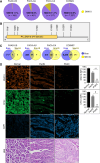Loss of Sorting Nexin 10 Accelerates KRAS-Induced Pancreatic Tumorigenesis
- PMID: 40810725
- PMCID: PMC12415682
- DOI: 10.1158/2767-9764.CRC-25-0168
Loss of Sorting Nexin 10 Accelerates KRAS-Induced Pancreatic Tumorigenesis
Abstract
Pancreatic ductal adenocarcinoma (PDAC), one of the most aggressive forms of pancreatic cancer, is associated with poor survival outcomes and currently ranks as the third leading cause of cancer-related death in the United States. Despite its clinical significance, the mechanisms of PDAC development and progression remain, in part, poorly understood. In this study, we provide evidence of a novel role of sorting nexin 10 (SNX10), a member of the sorting nexin family, in the regulation of KRAS-induced pancreatic carcinogenesis. We demonstrate that SNX10 is downregulated in PDAC, especially in advanced cases. Furthermore, mutational analysis revealed SNX10 genetic alterations in PDAC cases. Functional studies demonstrated that SNX10 overexpression in human PDAC cells inhibited cell proliferation and colony formation. Moreover, SNX10 overexpression induced G1-phase cell-cycle arrest and decreased KRAS signaling activity. Using a novel Snx10 knockout mouse crossed with a Kras-driven PDAC model, we observed reduced survival, increased tumor cell proliferation, enhanced aggression, and heightened inflammation. Collectively, these findings highlight SNX10 as a tumor suppressor candidate in PDAC and underscore its promise as a foundation for new therapeutic approaches.
Significance: SNX10 plays a crucial role in reducing pancreatic tumorigenesis. This discovery offers valuable insights into PDAC's biology and the development of new effective treatments.
©2025 The Authors; Published by the American Association for Cancer Research.
Conflict of interest statement
No disclosures were reported.
Figures





Similar articles
-
MICAL2 Promotes Pancreatic Cancer Growth and Metastasis.Cancer Res. 2025 Mar 14;85(6):1049-1063. doi: 10.1158/0008-5472.CAN-24-0744. Cancer Res. 2025. PMID: 39745352 Free PMC article.
-
Pancreatic STAT5 activation promotes KrasG12D-induced and inflammation-induced acinar-to-ductal metaplasia and pancreatic cancer.Gut. 2024 Oct 7;73(11):1831-1843. doi: 10.1136/gutjnl-2024-332225. Gut. 2024. PMID: 38955401 Free PMC article.
-
PLAGL2 as a prognostic biomarker and an EMT-promoting factor in PDAC.Sci Rep. 2025 Jul 14;15(1):25425. doi: 10.1038/s41598-025-09591-x. Sci Rep. 2025. PMID: 40659704 Free PMC article.
-
KRAS: the Achilles' heel of pancreas cancer biology.J Clin Invest. 2025 Aug 15;135(16):e191939. doi: 10.1172/JCI191939. eCollection 2025 Aug 15. J Clin Invest. 2025. PMID: 40829181 Free PMC article. Review.
-
Drugging the 'undruggable' KRAS: breakthroughs, challenges, and opportunities in pancreatic cancer.Cancer Biol Med. 2025 Jul 7;22(7):762-88. doi: 10.20892/j.issn.2095-3941.2025.0122. Cancer Biol Med. 2025. PMID: 40624835 Free PMC article. Review.
References
MeSH terms
Substances
LinkOut - more resources
Full Text Sources
Medical
Miscellaneous

